Turkey or Ham? Potatoes or Sweet Potatoes? Broccoli or Cauliflower? Spinach or Kale? Beetroot or Parsnip? Steamed pudding or pavlova?
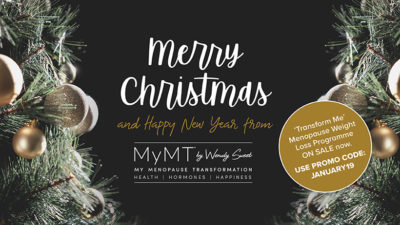 Of all the hundreds of coaching posts that I’ve written for women who join me in the private MyMT communities for my three different 12 week programmes – [Circuit Breaker, Transform Me & my new Re-Build My Fitness community], if there’s one thing I’ve learnt, it’s that when I mention food that helps hot flushes, I get the most reaction out of them. ????
Of all the hundreds of coaching posts that I’ve written for women who join me in the private MyMT communities for my three different 12 week programmes – [Circuit Breaker, Transform Me & my new Re-Build My Fitness community], if there’s one thing I’ve learnt, it’s that when I mention food that helps hot flushes, I get the most reaction out of them. ????
If you’ve been following my newsletter for a while now, then you’ll hopefully have been reading my posts over the past year and taking information from these in ways that can help you. I hope so. That’s why I write them! It’s been such a great year for me – I have traveled the length of New Zealand doing my Masterclass on Menopause seminars (if you missed this, then please watch my EVENT page as already there is CANBERRA coming up on March 26th, 2019) and I’ve been so grateful to the amazing women in the community hosting these events, who are just as passionate about menopause and turning around our symptoms and helping women to improve their mid-life energy and vitality as I am.
I was particularly humbled when Sue Coleman-Price presented me with the most beautiful, meaningful acknowledgment of all – a gift of pounamu/greenstone aroha (love) for all that I have done to help her become a leading Personal Trainer in Northland.
 She said that the knowledge and expertise that she got from doing my education courses years ago, has enabled her to help women feel better in the various communities where she works as a Personal Trainer. I was so surprised and very humbled.
She said that the knowledge and expertise that she got from doing my education courses years ago, has enabled her to help women feel better in the various communities where she works as a Personal Trainer. I was so surprised and very humbled.
Christmas is always a challenging time when we are in our menopause transition. I know this only too well. As women, often the success of the day relies on all that we do. But when energy is low and we having lots of hot flushes and haven’t slept well, then maintaining our enthusiasm and joy de vivre can be very difficult. That’s why it’s been such a privilege to help hundreds of women in 2018, understand how to adjust their lifestyle to suit their changing hormones and get back to how they used to feel before menopause hormonal changes arrived.
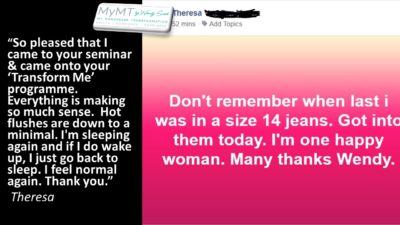 I remember only too well how difficult this time of my life was too. But because many of you haven’t joined me yet [don’t forget my JANUARY WEIGHT LOSS INTAKE starts soon, so you can sign up any time from now – see below for the promo code], and because Christmas is only a few days away, then I just wanted to share some foodie-tips which I’ve researched specifically for you at this time of year.
I remember only too well how difficult this time of my life was too. But because many of you haven’t joined me yet [don’t forget my JANUARY WEIGHT LOSS INTAKE starts soon, so you can sign up any time from now – see below for the promo code], and because Christmas is only a few days away, then I just wanted to share some foodie-tips which I’ve researched specifically for you at this time of year.
What to eat when you’re feeling beat:
Fatigue for mid-life women is near epidemic proportions. Not sleeping, feeling tired all the time, the incredible change in health with post-menopause obesity, metabolic syndrome and hypertension – the post -menopausal health stats in many western countries including Australia, New Zealand, America and the United Kingdom don’t lie. Whilst a lot of this health chaos is to do with the way our sleep hormones change as we go through menopause, much of our mid-life fatigue is also about our diet. When you’re feeling beat, your diet matters. But what matters even more, is that you are eating for your menopause hormonal changes – not eating food that is better suited to athletes, males or kids!

Numerous studies have shown that changes in the levels of nerve transmitters in the brain (neuro-transmitters), such as dopamine and nor-epinephrine, can dramatically affect your energy levels as you go through menopause too. These brain chemicals can decline during menopause alongside our changing oestrogen levels, especially when we don’t sleep. When we have lots of these chemicals however, then we feel more alert and energetic, so the goal is always to keep these powerful brain transmitters as high as you can to offset the changes associated with menopause. Eating the right food does this, as does learning to sleep all night and doing the right exercise to help our brain hormones.
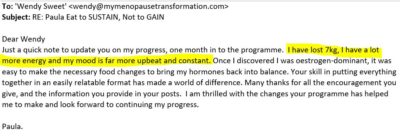 This is why women love the food and recipes I have in the MyMT programme – I’ve done the nutrition research and every bit of food advice is geared up for us in menopause, which is the gateway to our ageing. So, with Christmas just around the corner, I want to share some of this information with you too. Hot flushes can drive us crazy, especially when the weather heats up down-under in New Zealand and Australia. So, as my Christmas gift to you, if you are in the kitchen on Christmas Day, then make sure that you have these foods on your menu too. They’ll be on mine as well.
This is why women love the food and recipes I have in the MyMT programme – I’ve done the nutrition research and every bit of food advice is geared up for us in menopause, which is the gateway to our ageing. So, with Christmas just around the corner, I want to share some of this information with you too. Hot flushes can drive us crazy, especially when the weather heats up down-under in New Zealand and Australia. So, as my Christmas gift to you, if you are in the kitchen on Christmas Day, then make sure that you have these foods on your menu too. They’ll be on mine as well.
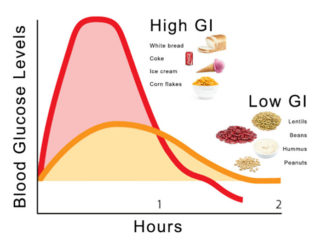 Your goal? – To eat foods that don’t spike your blood sugar levels, but instead, they help to boost your mood and help you to manage your blood pressure.
Your goal? – To eat foods that don’t spike your blood sugar levels, but instead, they help to boost your mood and help you to manage your blood pressure.
When blood sugar levels are high, then your pancreas is thrown into producing more insulin. And when insulin is high, then your hot flushes are worse, making your heart rate and blood pressure soar. If you aren’t sleeping, then over time, inflammation builds up in your cells and tissues. What you may feel is more hot flush chaos at Christmas.
If you’re in charge of the food going on your table this Christmas, then here are my Top 6 foods to help you. Forget the Christmas menu’s of celebrity chefs who don’t understand the powerful link between hot flushes, high blood pressure and mood in menopause!
1. Turkey or Ham?
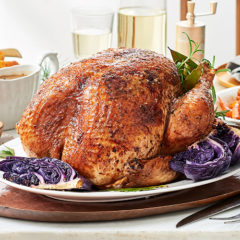 The building block for our mood hormones, dopamine and nor-epinephrine, is the amino acid (protein), tyrosine. This protein is elevated when you do two things:
The building block for our mood hormones, dopamine and nor-epinephrine, is the amino acid (protein), tyrosine. This protein is elevated when you do two things:
1) Have good gut health because it is absorbed in the small intestine and, 2) when you eat tyrosine-rich protein. It’s why on the Christmas menu, I will have the Turkey and pass on the processed ham which doesn’t have the tyrosine levels of turkey.
2. Sweet Potatoes [Kumara] or Potatoes?
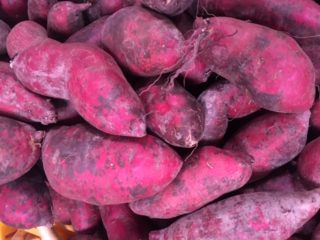 I’m definitely throwing sweet potatoes into the roasting pan. Packed full of anti-oxidant goodness (antioxidant-rich foods contain powerful nutrients that have been researched to heal already damaged cells and help to prevent further damage), the sweet potato is also full of fibre to help you feel full. But there’s more to this too. Sweet potato, despite their name (I prefer the New Zealand name of Kumara), don’t taste sweet at all. They are on the list of low to moderate glycemic index [GI] foods, which means that when you choose sweet potatoes over ordinary potatoes, your insulin response remains low. On the island of Okinawa, where some of the world’s longest living healthy women live, their age and good health is partly attributed to the sweet potato. Over 70% of their weekly diet is this wonderful vegetable. This is why, with menopause being the gateway to our biological ageing, sweet potato gets my tick for not only providing us with sustainable energy, but also because of it’s lower GI compared with the more common white potato.
I’m definitely throwing sweet potatoes into the roasting pan. Packed full of anti-oxidant goodness (antioxidant-rich foods contain powerful nutrients that have been researched to heal already damaged cells and help to prevent further damage), the sweet potato is also full of fibre to help you feel full. But there’s more to this too. Sweet potato, despite their name (I prefer the New Zealand name of Kumara), don’t taste sweet at all. They are on the list of low to moderate glycemic index [GI] foods, which means that when you choose sweet potatoes over ordinary potatoes, your insulin response remains low. On the island of Okinawa, where some of the world’s longest living healthy women live, their age and good health is partly attributed to the sweet potato. Over 70% of their weekly diet is this wonderful vegetable. This is why, with menopause being the gateway to our biological ageing, sweet potato gets my tick for not only providing us with sustainable energy, but also because of it’s lower GI compared with the more common white potato.
3. Broccoli or Cauliflower?
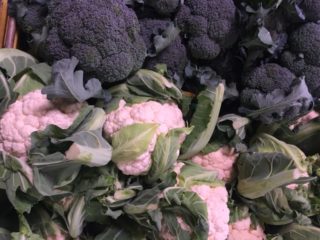 I’ve talked a lot about broccoli on my coaching groups this year. Mainly because of the role it plays in helping to clear oestrogen from our fat cells and liver ducts. Although evidence has been mounting that broccoli is great for cancer prevention, for women in menopause and post-menopause, equal evidence suggests that the nutrients in broccoli help to protect against heart disease. With most health research tending to focus on the sulforaphane in broccoli which helps to block cancer-producing enzymes, I prefer broccoli for women in menopause, because it is also high in beta-carotene.
I’ve talked a lot about broccoli on my coaching groups this year. Mainly because of the role it plays in helping to clear oestrogen from our fat cells and liver ducts. Although evidence has been mounting that broccoli is great for cancer prevention, for women in menopause and post-menopause, equal evidence suggests that the nutrients in broccoli help to protect against heart disease. With most health research tending to focus on the sulforaphane in broccoli which helps to block cancer-producing enzymes, I prefer broccoli for women in menopause, because it is also high in beta-carotene.
This powerful nutrient is converted to Vitamin A and helps to prevent heart disease as well as helping to heal a lifetime of damaged cells and tissues. Very important for those of you who do lots of exercise! Cauliflower shouldn’t miss out on the attention either because it is full of healthy nutrients as well, but the problem with cauliflower compared to broccoli, is that it has greater amounts of purines in it. These are amino acids that break down to uric acid in the body. As any of you with sore joints and gout know, you need to be careful of your purine consumption. Many women on the MyMT progra
mmes have sore joints when they start out, so being careful about purine consumption is something that you will find in the MyMT™ nutritional information too. Both these wonderful vegetables get my vote and I will be having them at the Christmas lunch, but they will be cooked, not raw and more broccoli than cauli will be on my plate!
4. Spinach or Kale?:
Spinach every time. 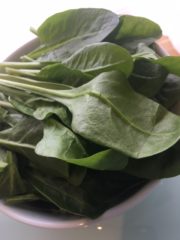 Despite the popularity of Kale, women in menopause don’t need to go over-board with kale in their diet. In fact, I have pretty much gone back to spinach and silverbeet myself and on Christmas morning I’ll quickly wilt some spinach to have with avocado on my toast. Kale and other cruciferous vegetables (broccoli, cauliflower and brussel sprouts) contain phytochemicals called glucosinolates. The popular way to eat these vegetables these days is raw. However, raw isn’t always best. And although cruciferous vegetables are great for helping clear the liver of excess oestrogens and toxins – [important for those of you who have had breast cancer and are on tamoxifen or other oestrogen-blocking meds], the conversion of glucosinolates in the raw form, compete with iodine for uptake into the thyroid. During menopause, when we need our thyroid to be functioning well to help regulate our hot flushes and metabolism, if we don’t have enough iodine in our diet, our temperature regulation can go a bit askew, making our hot flushes and night sweats worse.
Despite the popularity of Kale, women in menopause don’t need to go over-board with kale in their diet. In fact, I have pretty much gone back to spinach and silverbeet myself and on Christmas morning I’ll quickly wilt some spinach to have with avocado on my toast. Kale and other cruciferous vegetables (broccoli, cauliflower and brussel sprouts) contain phytochemicals called glucosinolates. The popular way to eat these vegetables these days is raw. However, raw isn’t always best. And although cruciferous vegetables are great for helping clear the liver of excess oestrogens and toxins – [important for those of you who have had breast cancer and are on tamoxifen or other oestrogen-blocking meds], the conversion of glucosinolates in the raw form, compete with iodine for uptake into the thyroid. During menopause, when we need our thyroid to be functioning well to help regulate our hot flushes and metabolism, if we don’t have enough iodine in our diet, our temperature regulation can go a bit askew, making our hot flushes and night sweats worse.
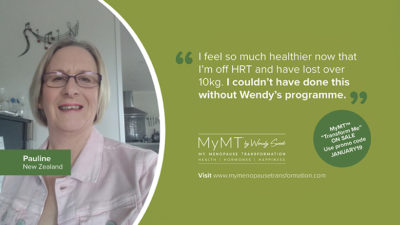 I have an entire module on HOT FLUSH MANAGEMENT in the MyMT™ programmes and a list of what cooling carbs to include in your diet is on a handout for you to take to the supermarket or where-ever you shop for vegies. On this list is Spinach and Silverbeet – slightly cooked with a sprinkle of iodised salt, for Christmas Day, it helps our thyroid to function. When we love our thyroid and keep it functioning with iodine, our blood pressure stays stable and we help to manage our hot flushes.
I have an entire module on HOT FLUSH MANAGEMENT in the MyMT™ programmes and a list of what cooling carbs to include in your diet is on a handout for you to take to the supermarket or where-ever you shop for vegies. On this list is Spinach and Silverbeet – slightly cooked with a sprinkle of iodised salt, for Christmas Day, it helps our thyroid to function. When we love our thyroid and keep it functioning with iodine, our blood pressure stays stable and we help to manage our hot flushes.
5. Beetroot or Parsnips?
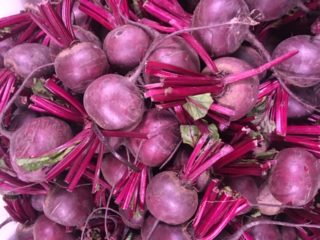 For years, I didn’t eat beetroot (beets) because my family hated them. I wish that I had over-ruled them, but as women cooking and preparing food for the family it’s so easy to put our nutritional needs behind those of others. Nowadays, with my women’s healthy ageing research in front of me, teamed up with my background in sports and exercise science, I know that beetroot wins hands down over parsnips. Although I love parsnips and they are very healthy and useful for us, if I was to choose a vegie that was specific to my needs in menopause, then it would be beetroot. In fact, I tell women to make it into a powerful juice with other vegies and apples, especially before or after exercise. Sports science research has emerged about the role of beetroot as a vaso-dilator. This means that compounds in beets (dietary nitrates) may assist in helping to dilate blood vessels, therefore, improving oxygen uptake. But dietary nitrates may also have a role in reducing blood pressure, so if you already have high blood pressure from the stress of Christmas or not sleeping well during menopause, or you do lots of high intensity exercise or heavy power-lifting, and these are all types of exercise that can elevate blood pressure in menopausal women, then bring on beets! The effect of dietary nitrates on blood pressure as we transition through menopause and into post-menopause is important. But conversely, if women have low blood pressure, then be careful of having beetroot juices. You might just feel yourself feeling a bit light-headed!
For years, I didn’t eat beetroot (beets) because my family hated them. I wish that I had over-ruled them, but as women cooking and preparing food for the family it’s so easy to put our nutritional needs behind those of others. Nowadays, with my women’s healthy ageing research in front of me, teamed up with my background in sports and exercise science, I know that beetroot wins hands down over parsnips. Although I love parsnips and they are very healthy and useful for us, if I was to choose a vegie that was specific to my needs in menopause, then it would be beetroot. In fact, I tell women to make it into a powerful juice with other vegies and apples, especially before or after exercise. Sports science research has emerged about the role of beetroot as a vaso-dilator. This means that compounds in beets (dietary nitrates) may assist in helping to dilate blood vessels, therefore, improving oxygen uptake. But dietary nitrates may also have a role in reducing blood pressure, so if you already have high blood pressure from the stress of Christmas or not sleeping well during menopause, or you do lots of high intensity exercise or heavy power-lifting, and these are all types of exercise that can elevate blood pressure in menopausal women, then bring on beets! The effect of dietary nitrates on blood pressure as we transition through menopause and into post-menopause is important. But conversely, if women have low blood pressure, then be careful of having beetroot juices. You might just feel yourself feeling a bit light-headed!
6. Steamed Pudding or Pavlova?
What a conundrum! Who likes Christmas dessert? Silly question I know. ???? This was a tough one, but as much as I love a good steamed pudding full of delicious raisins and covered in hot custard, for women who don’t tolerate wheat or sugar very well, steamed pudding is hot flush hell and for those with poor gut health, with the wheat from flour, then it can cause those of you who are gluten intolerant a bit of grief!
 Whilst one could argue that the pavlova is higher in sugar and therefore, will also give you a sugar-rush and therefore, increase insulin and hot flushes, the pavlova wins for me. This is because it is higher in protein as it’s made from amino-acid rich egg whites. Protein helps to off-set the insulin response from the sugar (you could also use less sugar and I now use an organic brand).
Whilst one could argue that the pavlova is higher in sugar and therefore, will also give you a sugar-rush and therefore, increase insulin and hot flushes, the pavlova wins for me. This is because it is higher in protein as it’s made from amino-acid rich egg whites. Protein helps to off-set the insulin response from the sugar (you could also use less sugar and I now use an organic brand).
I always buy Cowell’s Pavlova here in New Zealand. The late Mrs Cowell, who founded the pavlova company with her husband, used to live across the road from me when I lived in Dunedin. I still remember her bringing over beautiful pavlova slices to celebrate my daughter’s birth. So maybe I’m a bit biased when it comes to pavlova versus steamed pudding, but when served with fresh berries you also have a good dose of a compound called ellagic acid. This powerful compound is another one of nature’s anti-oxidants and for women in menopause, it helps to fight inflammation and harmful free radicals.
I always explain to women in my seminars that menopause is the transition into our biological ageing, so as my PhD was on women’s healthy ageing and exercise, I began to investigate all the influences that may have caused inflammatory changes in the body from decades of exercising. My own joints and muscles felt sore and achey and don’t even mention ‘restless leg syndrome’ [this is so common for women who are exercising and I talk about it in my programmes, especially for women who exercise daily], so I looked into what was really going on. Our joints, muscles and nerves all contain oestrogen receptors, so going into a low oestrogen hormonal environment affects these structures too. Hence, why we need lovely anti-inflammatory berries to help heal and prevent further damage caused by free radicals. Fortunately, here in New Zealand, raspberries and blueberries are in-season, but if you are in the Northern Hemisphere, then frozen is fine (preferably organic).
 I hope you all have a lovely Christmas and I want to say thank you for being part of the MyMT community. With over 1000 women from 14 countries, having gone through the MyMT programmes, I know that menopause matters! It can be a crazy time of life, so I want to reassure you that the programmes and plans that I have for you are all focused on this age and stage of life. It’s so important to turn around our sleep, hot flushes, blood pressure, weight and sore joints before going into our post-menopause years makes it that little bit tougher to turn around our health.
I hope you all have a lovely Christmas and I want to say thank you for being part of the MyMT community. With over 1000 women from 14 countries, having gone through the MyMT programmes, I know that menopause matters! It can be a crazy time of life, so I want to reassure you that the programmes and plans that I have for you are all focused on this age and stage of life. It’s so important to turn around our sleep, hot flushes, blood pressure, weight and sore joints before going into our post-menopause years makes it that little bit tougher to turn around our health.
Don’t forget that the TRANSFORM ME MENOPAUSE WEIGHT LOSS programme is also ON SALE now ready for my January Intake. Please use the promo code JANUARY19 when you purchase and you can commence it any time throughout January. You also get a bonus month of my coaching and you can email me any time with questions or problems, so that the programme stays individual to your needs, not mine!
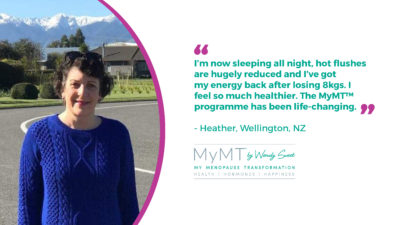 Please come and join me for 12 weeks (or longer as there is no pressure to get through the programme in 12 weeks). Make 2019 the year that you get back in control of your menopause symptoms through the MyMT programme that I’ve designed for you. Changing our lifestyle to suit our changing hormonal environment is the most powerful thing you can do. And it’s not just about food, it’s about sleep, joint health, exercise specific to mid-life, stress management and more …. You won’t find a more comprehensive course around. I know this, because I tried to find one too.
Please come and join me for 12 weeks (or longer as there is no pressure to get through the programme in 12 weeks). Make 2019 the year that you get back in control of your menopause symptoms through the MyMT programme that I’ve designed for you. Changing our lifestyle to suit our changing hormonal environment is the most powerful thing you can do. And it’s not just about food, it’s about sleep, joint health, exercise specific to mid-life, stress management and more …. You won’t find a more comprehensive course around. I know this, because I tried to find one too.

References:
Lidder, S. & Webb, A. (2013). Vascular effects of dietary nitrates as found in green leafy vegetables and beetroot. J. Clin. Pharmacology, 75(3), 677-696.
Rienks, A., Van der Woude, et al. (2015) Effect of Beetroot Juice on Moderate-Intensity Exercise at a Constant Rating of Perceived Exertion. Int. Journal of Exercise Science, 8(3): 277-297.
Siervo M., Lara J. et al. (2013). Inorganic nitrate and beetroot juice supplementation reduces blood pressure in adults: a systematic review and meta-analysis. J. Nutrition. 143(6): 818-826.


